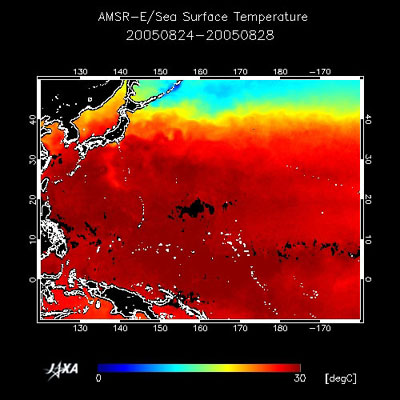Seen from Space 2005
Footprint Left on Sea Surface by Typhoon 200511 "Mawar"
Typhoon Mawar (meaning "Rose" in Malaysian) struck the Kanto region of Japan on August 26, 2005 and left its footprint upon the sea just offshore of the Tokai region. Figure shows a five-day average (from August 24 to August 28) of sea-surface temperatures as observed by a microwave sensor, the Advanced Microwave Scanning Radiometer for EOS (AMSR-E). The red hatching on the sea surface represents high temperatures, and the blue hatching represents low temperatures (between 0°C and 30°C. The black hatching represents land and regions that were not observable due to thick clouds. Nearly the entire southern part of Japan is hatched in dark red, indicating temperatures of approximately 30°C. There is bright red hatched area surrounding the dark red hatched area along and to the west of the Izu and Ogasawara Islands. This bright red area is the footprint of typhoon Mawar. At the sea surface during a typhoon, strong winds stir the hot surface water and the cold water below it, cooling the surface water, so the footprint of the typhoon is cooler than the surrounding seas. Typhoon Mawar began to form south of the Ogasawara Islands on August 20, 2005, and quickly developed a central atmospheric pressure of 930 hPa by August 22. Mawar gradually weakened, moving northward, grazing the Izu Peninsula. It struck the city of Chiba on Tokyo Bay on August 26 and became an extratropical cyclone in the area offshore of Kujuu-kuri-hama on August 28. By the time the typhoon struck the coast, it produced 528 mm of measurable precipitation for one day at Hakone and 57.0 m/s of wind velocity (averaged over ten minutes) at Izu Oshima Island. It caused great destruction, blocking traffic and cutting off supplies when it struck Tokyo and the Kanto region. In the report on the typhoon's track by the JAXA/EORC Tropical Cyclone Database, we see that Typhoon Mawar traveled from August 20 to August 28 in a clockwise arc (semicircle). The typhoon track almost matches the bright-red hatching (cooler area) of the figure This cooler area of sea surface disappears a few days afterward due to the heat of the sunshine and the surrounding hot water. The large meandering Kuroshio Current is not visible in the figure. On September 12, the Japan Meteorological Agency announced that it had ended in August 2005. JAXA will continue using spacecraft observation to identify such otherwise invisible phenomenon.
|
|||||||||||||





